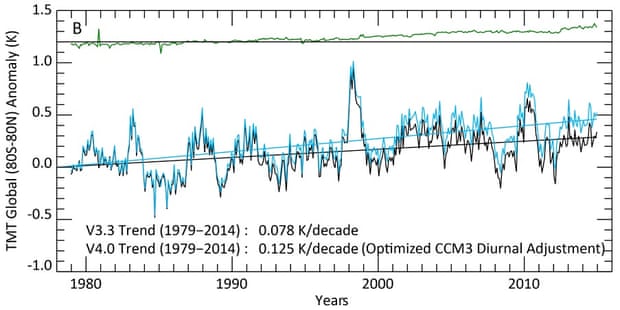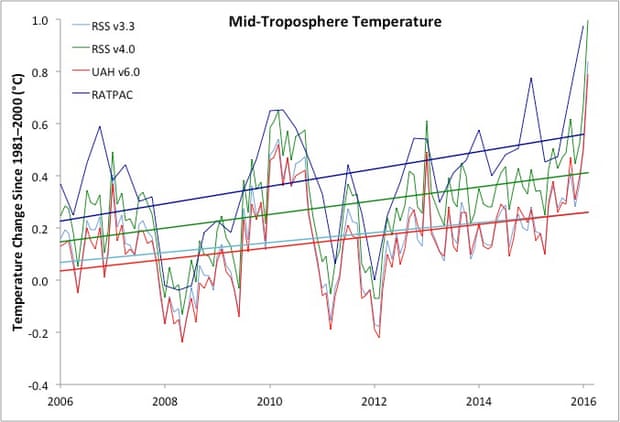
In a new paper, Carl Mears and Frank Wentz at Remote Sensing Systems (RSS) have revised their data set estimating the temperature of the Earth’s atmosphere. At his recent congressional hearing, Ted Cruz presented the RSS data to incorrectly claim that there’s been no global warming in over 18 years.
Even other estimates of the atmospheric temperature, of the same satellite data by scientists at the University of Alabama at Huntsville (UAH), and by weather balloons, indicate that the atmosphere is warming. Ted Cruz cherry picked RSS because it was the lone outlier that seemed to support his preferred argument against the need to take action to mitigate the risks posed by human-caused global warming.
That’s no longer the case. In their new paper, Mears and Wentz detail the revised RSS method to account for drift in the time of day at which satellites measure the same location on Earth (known as “diurnal drift”, discussed by Mears at the 0:47 mark in the above video). They applied a method suggested by Stephen Po-Chedley and colleagues at the University of Washington in an important paper covered by John Abraham last year. As a result, the new version of RSS (v4.0) shows about 60% more warming than the previous version (v3.3) since the record began in 1979.

RSS mid-troposphere temperature, v3.3 and v4.0. Illustration: Mears & Wentz (2016), Journal of Climate.
This new adjustment also helps to reconcile the divergence between atmospheric temperature estimates from satellites and weather balloons. Over most of the temperature record, the estimates using the two different types of instruments have been similar, and the satellite data are calibrated with the weather ballon data. However, over the past decade, the weather balloons had shown significantly more atmospheric warming than the satellite estimates. RSS v4.0 goes a long way toward bringing these measurements into closer agreement.

Mid troposphere temperature estimates and linear trends (2006–2015) from RSS v3.3, RSS v4.0, UAH v6.0, and weather balloons (RATPAC). Illustration: Dana Nuccitelli
As Joe Romm noted at Climate Progress, Roy Spencer and John Christy at UAHspeculated over 4 years ago that the RSS diurnal drift correction method was introducing a cool bias into their record.
my UAH cohort and boss John Christy, who does the detailed matching between satellites, is pretty convinced that the RSS data is undergoing spurious cooling because RSS is still using the old NOAA-15 satellite which has a decaying orbit, to which they are then applying a diurnal cycle drift correction based upon a climate model, which does not quite match reality.
This new paper and latest RSS adjustment once again highlight the challenges scientists face in converting measurements of atmospheric microwave emissions by satellites in orbit into a synthetic temperature estimate. It’s a complicated process that requires a complex model with large uncertainties involved, and as Carl Mears has noted, it’s certainly unwise to rely exclusively on these estimates of one small component of the Earth’s climate to evaluate global warming.
Nevertheless, Spencer has just reported that February 2016 was the hottest month on record in the UAH data set; the same is true of RSS, and weather balloons are also registering record hot atmospheric temperatures, as the above chart shows.
It’s now clear that Senator Cruz has been hoisted by his own petard.
Posted by dana1981 on Thursday, 3 March, 2016
 |
The Skeptical Science website by Skeptical Science is licensed under a Creative Commons Attribution 3.0 Unported License. |